Economic Impact Analysis: Raptor Resources Limited Business Report
VerifiedAdded on 2022/10/04
|12
|4059
|13
Report
AI Summary
This report provides a comprehensive economic analysis of Raptor Resources Limited, an Australian oil and energy company. It begins with an introduction to the business and its competitive environment, detailing its operations, customers, and competitors within the Australian market. The microanalysis delves into production costs, factors of production (land, labor, capital, and entrepreneurship), and the distinction between fixed and variable costs. A macro analysis examines the political and economic environment, including Australia's political system, inflation rate, unemployment rate, and exchange rate, and their impact on the company. The report also addresses the sustainability practices of Raptor Resources Limited and their influence on long-term business viability. The report determines the market to be perfectly competitive and the product to be normal. The report concludes with a discussion of the company's overall performance and future prospects.
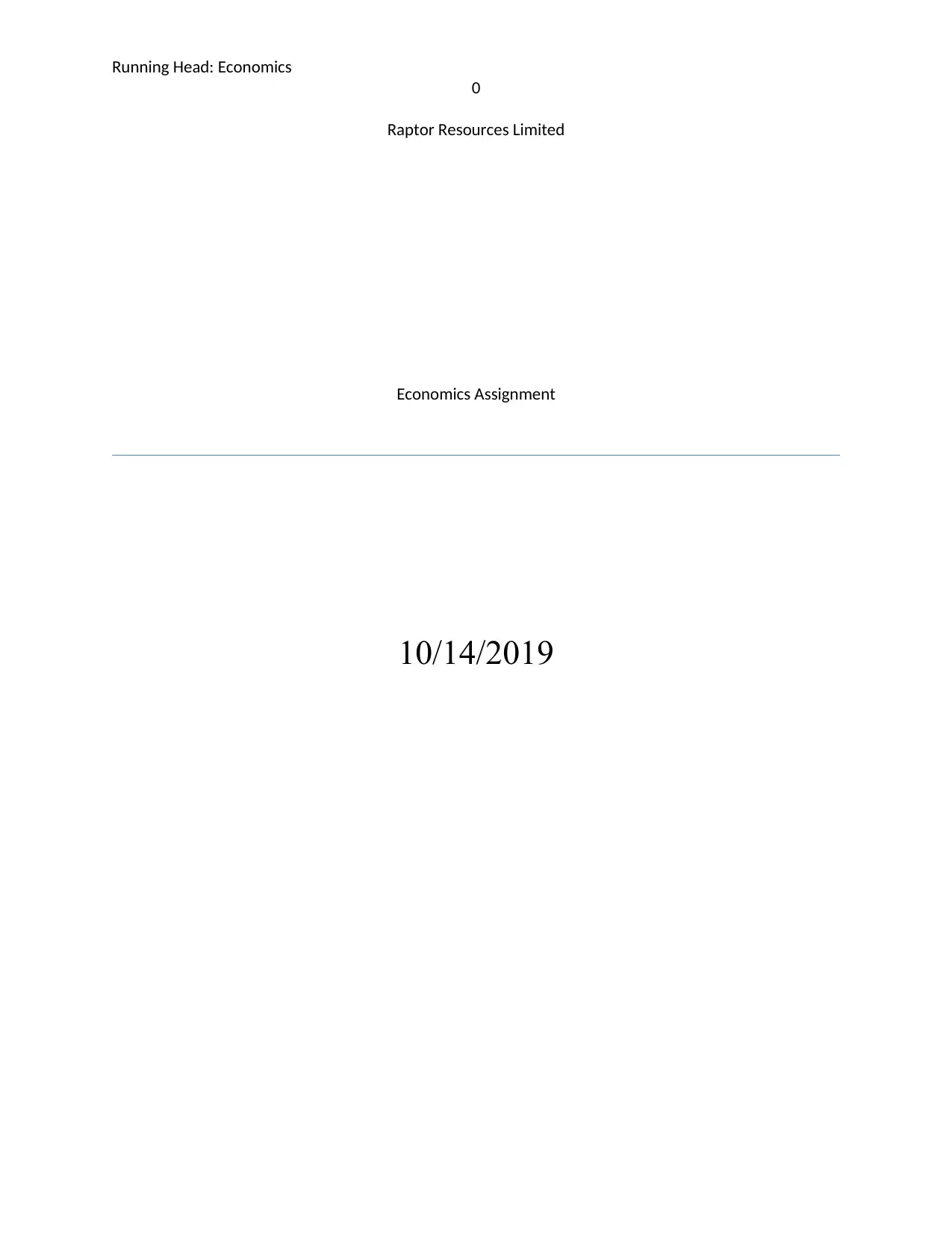
Running Head: Economics
0
Raptor Resources Limited
Economics Assignment
10/14/2019
0
Raptor Resources Limited
Economics Assignment
10/14/2019
Paraphrase This Document
Need a fresh take? Get an instant paraphrase of this document with our AI Paraphraser
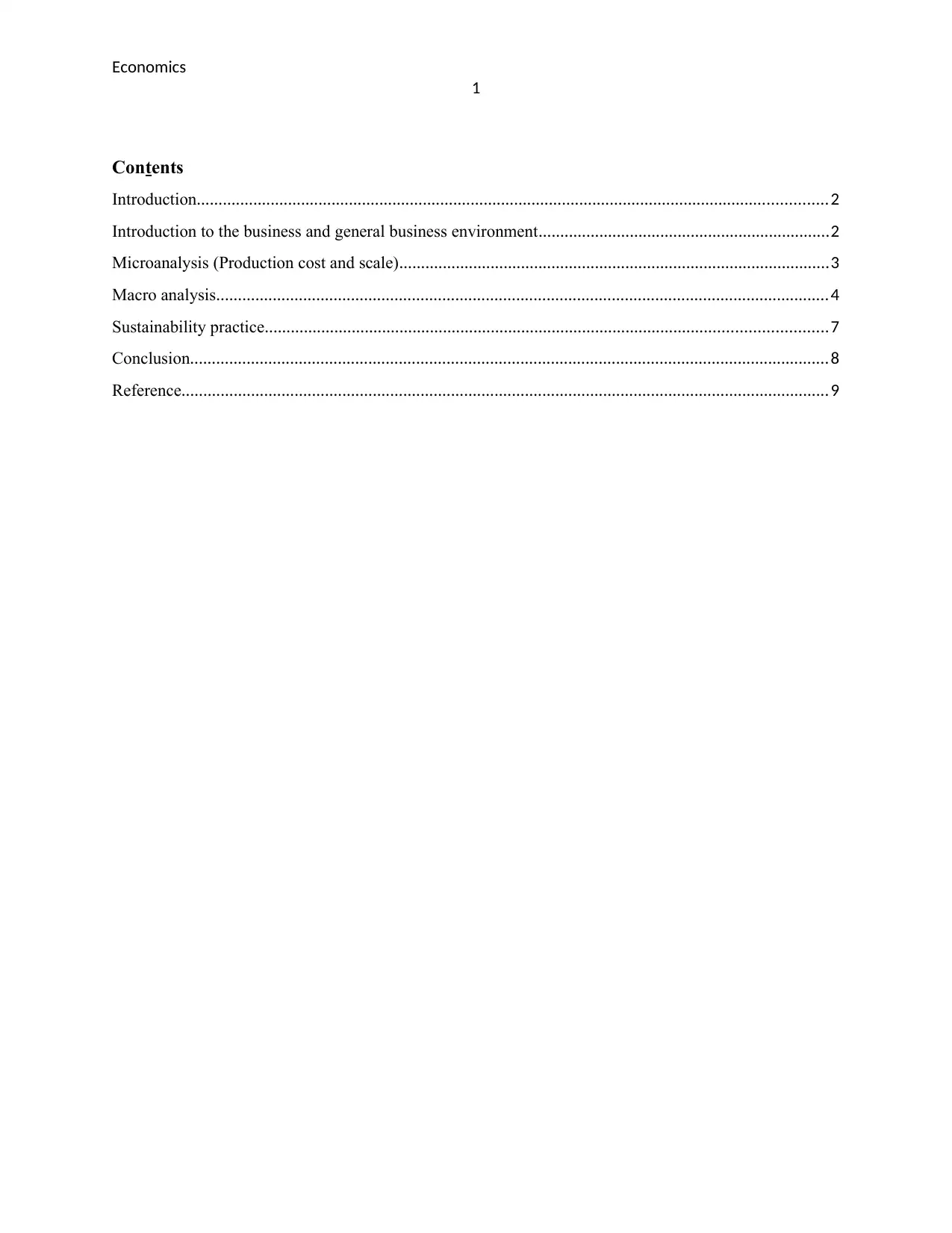
Economics
1
Contents
Introduction.................................................................................................................................................2
Introduction to the business and general business environment...................................................................2
Microanalysis (Production cost and scale)...................................................................................................3
Macro analysis.............................................................................................................................................4
Sustainability practice.................................................................................................................................7
Conclusion...................................................................................................................................................8
Reference.....................................................................................................................................................9
1
Contents
Introduction.................................................................................................................................................2
Introduction to the business and general business environment...................................................................2
Microanalysis (Production cost and scale)...................................................................................................3
Macro analysis.............................................................................................................................................4
Sustainability practice.................................................................................................................................7
Conclusion...................................................................................................................................................8
Reference.....................................................................................................................................................9
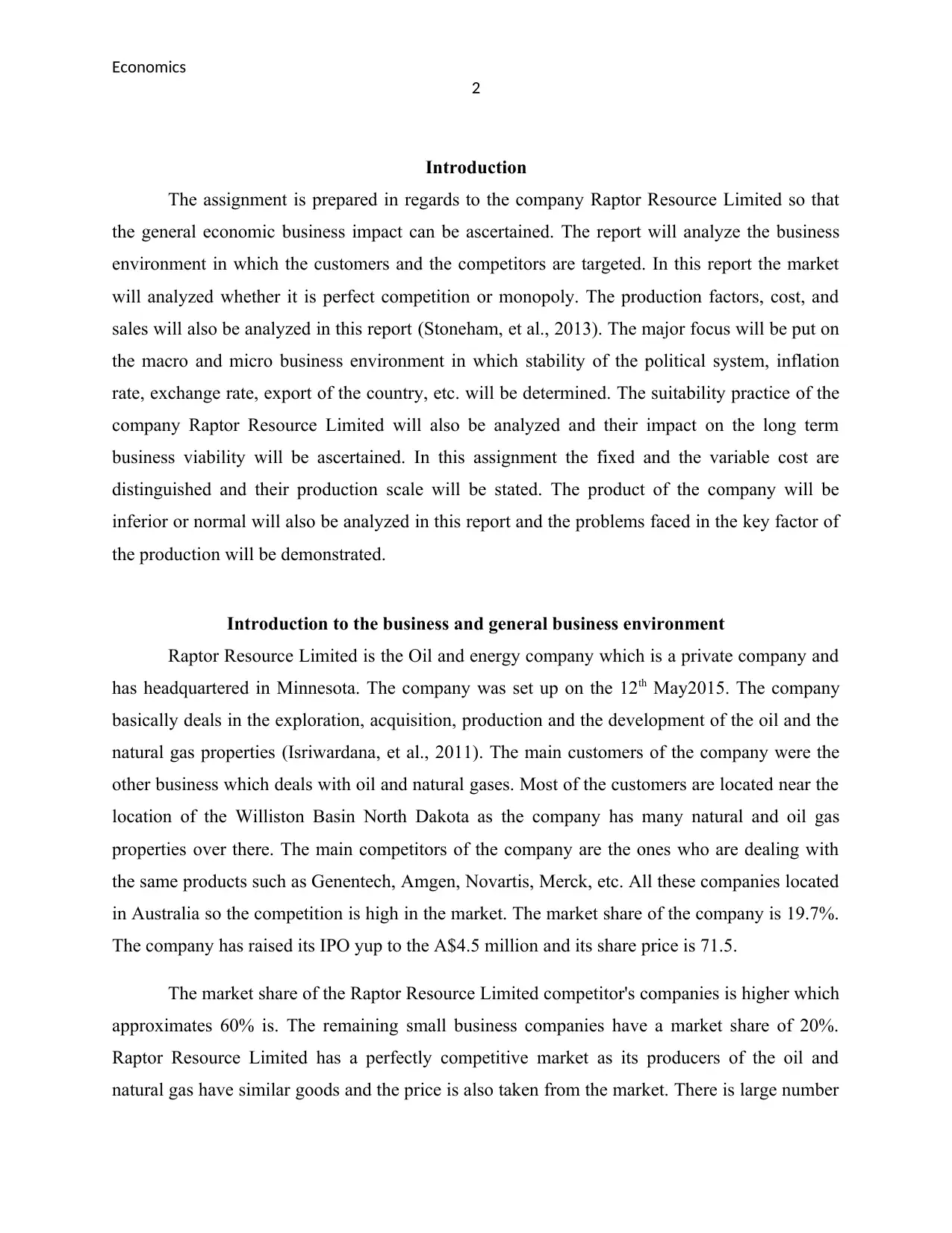
Economics
2
Introduction
The assignment is prepared in regards to the company Raptor Resource Limited so that
the general economic business impact can be ascertained. The report will analyze the business
environment in which the customers and the competitors are targeted. In this report the market
will analyzed whether it is perfect competition or monopoly. The production factors, cost, and
sales will also be analyzed in this report (Stoneham, et al., 2013). The major focus will be put on
the macro and micro business environment in which stability of the political system, inflation
rate, exchange rate, export of the country, etc. will be determined. The suitability practice of the
company Raptor Resource Limited will also be analyzed and their impact on the long term
business viability will be ascertained. In this assignment the fixed and the variable cost are
distinguished and their production scale will be stated. The product of the company will be
inferior or normal will also be analyzed in this report and the problems faced in the key factor of
the production will be demonstrated.
Introduction to the business and general business environment
Raptor Resource Limited is the Oil and energy company which is a private company and
has headquartered in Minnesota. The company was set up on the 12th May2015. The company
basically deals in the exploration, acquisition, production and the development of the oil and the
natural gas properties (Isriwardana, et al., 2011). The main customers of the company were the
other business which deals with oil and natural gases. Most of the customers are located near the
location of the Williston Basin North Dakota as the company has many natural and oil gas
properties over there. The main competitors of the company are the ones who are dealing with
the same products such as Genentech, Amgen, Novartis, Merck, etc. All these companies located
in Australia so the competition is high in the market. The market share of the company is 19.7%.
The company has raised its IPO yup to the A$4.5 million and its share price is 71.5.
The market share of the Raptor Resource Limited competitor's companies is higher which
approximates 60% is. The remaining small business companies have a market share of 20%.
Raptor Resource Limited has a perfectly competitive market as its producers of the oil and
natural gas have similar goods and the price is also taken from the market. There is large number
2
Introduction
The assignment is prepared in regards to the company Raptor Resource Limited so that
the general economic business impact can be ascertained. The report will analyze the business
environment in which the customers and the competitors are targeted. In this report the market
will analyzed whether it is perfect competition or monopoly. The production factors, cost, and
sales will also be analyzed in this report (Stoneham, et al., 2013). The major focus will be put on
the macro and micro business environment in which stability of the political system, inflation
rate, exchange rate, export of the country, etc. will be determined. The suitability practice of the
company Raptor Resource Limited will also be analyzed and their impact on the long term
business viability will be ascertained. In this assignment the fixed and the variable cost are
distinguished and their production scale will be stated. The product of the company will be
inferior or normal will also be analyzed in this report and the problems faced in the key factor of
the production will be demonstrated.
Introduction to the business and general business environment
Raptor Resource Limited is the Oil and energy company which is a private company and
has headquartered in Minnesota. The company was set up on the 12th May2015. The company
basically deals in the exploration, acquisition, production and the development of the oil and the
natural gas properties (Isriwardana, et al., 2011). The main customers of the company were the
other business which deals with oil and natural gases. Most of the customers are located near the
location of the Williston Basin North Dakota as the company has many natural and oil gas
properties over there. The main competitors of the company are the ones who are dealing with
the same products such as Genentech, Amgen, Novartis, Merck, etc. All these companies located
in Australia so the competition is high in the market. The market share of the company is 19.7%.
The company has raised its IPO yup to the A$4.5 million and its share price is 71.5.
The market share of the Raptor Resource Limited competitor's companies is higher which
approximates 60% is. The remaining small business companies have a market share of 20%.
Raptor Resource Limited has a perfectly competitive market as its producers of the oil and
natural gas have similar goods and the price is also taken from the market. There is large number
⊘ This is a preview!⊘
Do you want full access?
Subscribe today to unlock all pages.

Trusted by 1+ million students worldwide
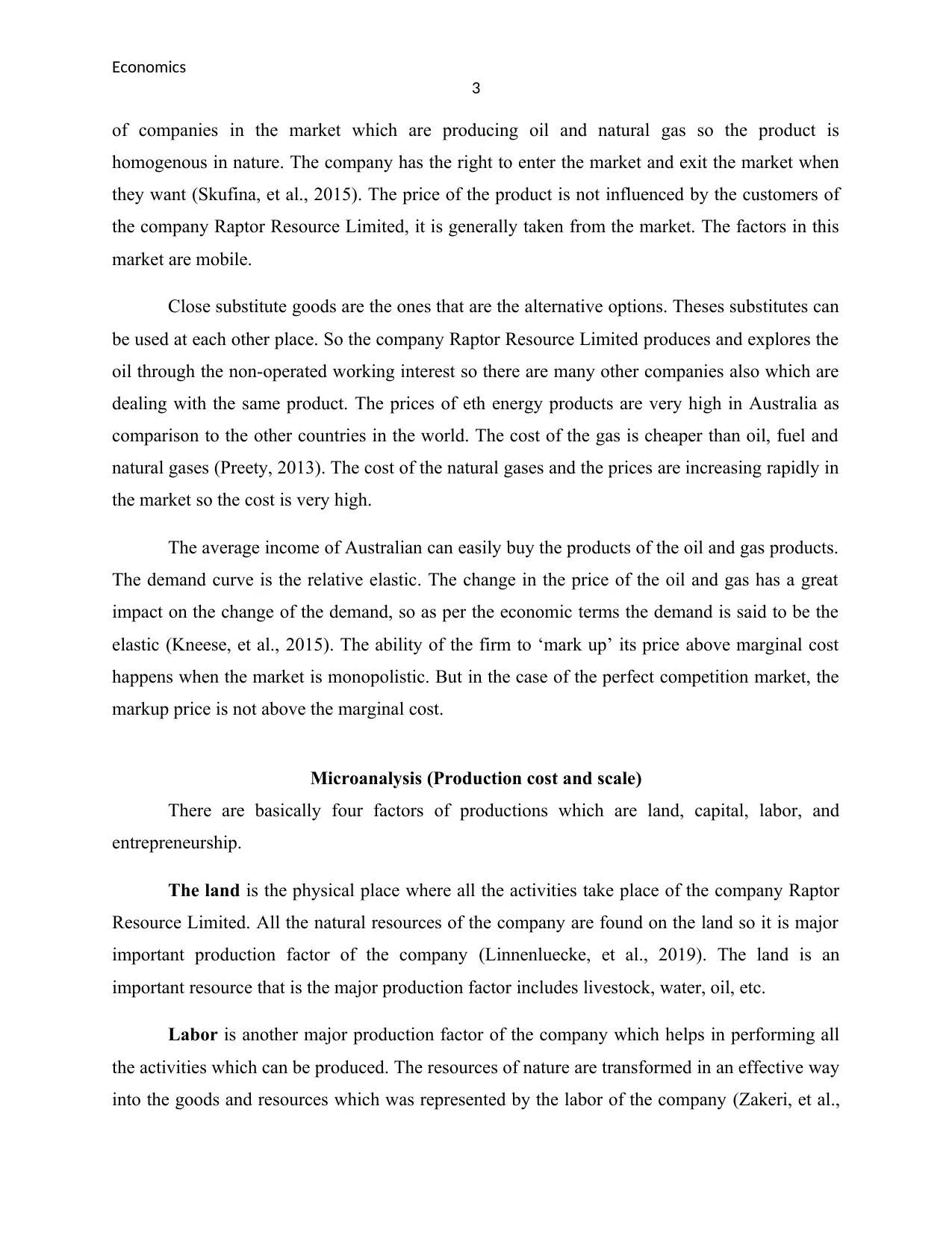
Economics
3
of companies in the market which are producing oil and natural gas so the product is
homogenous in nature. The company has the right to enter the market and exit the market when
they want (Skufina, et al., 2015). The price of the product is not influenced by the customers of
the company Raptor Resource Limited, it is generally taken from the market. The factors in this
market are mobile.
Close substitute goods are the ones that are the alternative options. Theses substitutes can
be used at each other place. So the company Raptor Resource Limited produces and explores the
oil through the non-operated working interest so there are many other companies also which are
dealing with the same product. The prices of eth energy products are very high in Australia as
comparison to the other countries in the world. The cost of the gas is cheaper than oil, fuel and
natural gases (Preety, 2013). The cost of the natural gases and the prices are increasing rapidly in
the market so the cost is very high.
The average income of Australian can easily buy the products of the oil and gas products.
The demand curve is the relative elastic. The change in the price of the oil and gas has a great
impact on the change of the demand, so as per the economic terms the demand is said to be the
elastic (Kneese, et al., 2015). The ability of the firm to ‘mark up’ its price above marginal cost
happens when the market is monopolistic. But in the case of the perfect competition market, the
markup price is not above the marginal cost.
Microanalysis (Production cost and scale)
There are basically four factors of productions which are land, capital, labor, and
entrepreneurship.
The land is the physical place where all the activities take place of the company Raptor
Resource Limited. All the natural resources of the company are found on the land so it is major
important production factor of the company (Linnenluecke, et al., 2019). The land is an
important resource that is the major production factor includes livestock, water, oil, etc.
Labor is another major production factor of the company which helps in performing all
the activities which can be produced. The resources of nature are transformed in an effective way
into the goods and resources which was represented by the labor of the company (Zakeri, et al.,
3
of companies in the market which are producing oil and natural gas so the product is
homogenous in nature. The company has the right to enter the market and exit the market when
they want (Skufina, et al., 2015). The price of the product is not influenced by the customers of
the company Raptor Resource Limited, it is generally taken from the market. The factors in this
market are mobile.
Close substitute goods are the ones that are the alternative options. Theses substitutes can
be used at each other place. So the company Raptor Resource Limited produces and explores the
oil through the non-operated working interest so there are many other companies also which are
dealing with the same product. The prices of eth energy products are very high in Australia as
comparison to the other countries in the world. The cost of the gas is cheaper than oil, fuel and
natural gases (Preety, 2013). The cost of the natural gases and the prices are increasing rapidly in
the market so the cost is very high.
The average income of Australian can easily buy the products of the oil and gas products.
The demand curve is the relative elastic. The change in the price of the oil and gas has a great
impact on the change of the demand, so as per the economic terms the demand is said to be the
elastic (Kneese, et al., 2015). The ability of the firm to ‘mark up’ its price above marginal cost
happens when the market is monopolistic. But in the case of the perfect competition market, the
markup price is not above the marginal cost.
Microanalysis (Production cost and scale)
There are basically four factors of productions which are land, capital, labor, and
entrepreneurship.
The land is the physical place where all the activities take place of the company Raptor
Resource Limited. All the natural resources of the company are found on the land so it is major
important production factor of the company (Linnenluecke, et al., 2019). The land is an
important resource that is the major production factor includes livestock, water, oil, etc.
Labor is another major production factor of the company which helps in performing all
the activities which can be produced. The resources of nature are transformed in an effective way
into the goods and resources which was represented by the labor of the company (Zakeri, et al.,
Paraphrase This Document
Need a fresh take? Get an instant paraphrase of this document with our AI Paraphraser
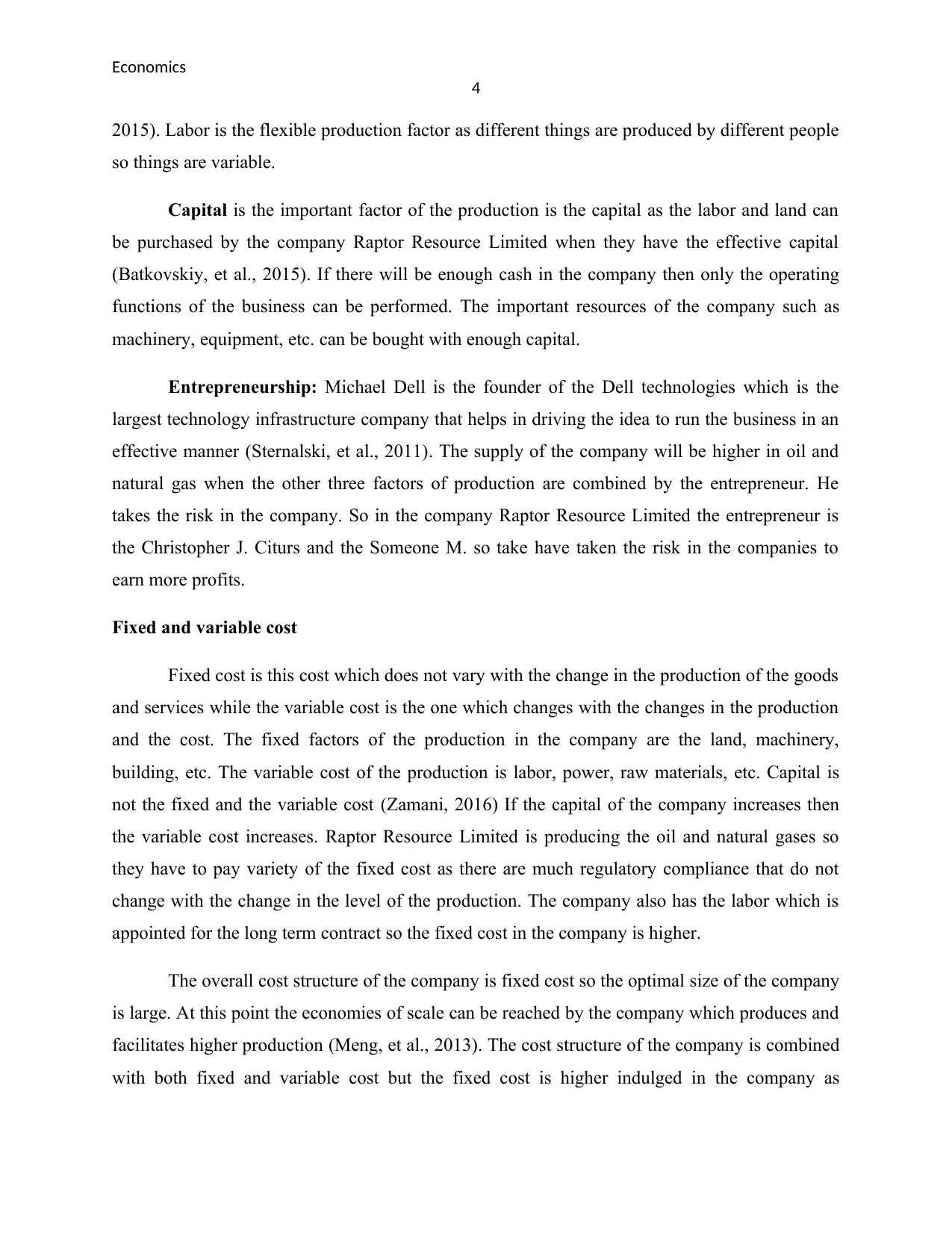
Economics
4
2015). Labor is the flexible production factor as different things are produced by different people
so things are variable.
Capital is the important factor of the production is the capital as the labor and land can
be purchased by the company Raptor Resource Limited when they have the effective capital
(Batkovskiy, et al., 2015). If there will be enough cash in the company then only the operating
functions of the business can be performed. The important resources of the company such as
machinery, equipment, etc. can be bought with enough capital.
Entrepreneurship: Michael Dell is the founder of the Dell technologies which is the
largest technology infrastructure company that helps in driving the idea to run the business in an
effective manner (Sternalski, et al., 2011). The supply of the company will be higher in oil and
natural gas when the other three factors of production are combined by the entrepreneur. He
takes the risk in the company. So in the company Raptor Resource Limited the entrepreneur is
the Christopher J. Citurs and the Someone M. so take have taken the risk in the companies to
earn more profits.
Fixed and variable cost
Fixed cost is this cost which does not vary with the change in the production of the goods
and services while the variable cost is the one which changes with the changes in the production
and the cost. The fixed factors of the production in the company are the land, machinery,
building, etc. The variable cost of the production is labor, power, raw materials, etc. Capital is
not the fixed and the variable cost (Zamani, 2016) If the capital of the company increases then
the variable cost increases. Raptor Resource Limited is producing the oil and natural gases so
they have to pay variety of the fixed cost as there are much regulatory compliance that do not
change with the change in the level of the production. The company also has the labor which is
appointed for the long term contract so the fixed cost in the company is higher.
The overall cost structure of the company is fixed cost so the optimal size of the company
is large. At this point the economies of scale can be reached by the company which produces and
facilitates higher production (Meng, et al., 2013). The cost structure of the company is combined
with both fixed and variable cost but the fixed cost is higher indulged in the company as
4
2015). Labor is the flexible production factor as different things are produced by different people
so things are variable.
Capital is the important factor of the production is the capital as the labor and land can
be purchased by the company Raptor Resource Limited when they have the effective capital
(Batkovskiy, et al., 2015). If there will be enough cash in the company then only the operating
functions of the business can be performed. The important resources of the company such as
machinery, equipment, etc. can be bought with enough capital.
Entrepreneurship: Michael Dell is the founder of the Dell technologies which is the
largest technology infrastructure company that helps in driving the idea to run the business in an
effective manner (Sternalski, et al., 2011). The supply of the company will be higher in oil and
natural gas when the other three factors of production are combined by the entrepreneur. He
takes the risk in the company. So in the company Raptor Resource Limited the entrepreneur is
the Christopher J. Citurs and the Someone M. so take have taken the risk in the companies to
earn more profits.
Fixed and variable cost
Fixed cost is this cost which does not vary with the change in the production of the goods
and services while the variable cost is the one which changes with the changes in the production
and the cost. The fixed factors of the production in the company are the land, machinery,
building, etc. The variable cost of the production is labor, power, raw materials, etc. Capital is
not the fixed and the variable cost (Zamani, 2016) If the capital of the company increases then
the variable cost increases. Raptor Resource Limited is producing the oil and natural gases so
they have to pay variety of the fixed cost as there are much regulatory compliance that do not
change with the change in the level of the production. The company also has the labor which is
appointed for the long term contract so the fixed cost in the company is higher.
The overall cost structure of the company is fixed cost so the optimal size of the company
is large. At this point the economies of scale can be reached by the company which produces and
facilitates higher production (Meng, et al., 2013). The cost structure of the company is combined
with both fixed and variable cost but the fixed cost is higher indulged in the company as
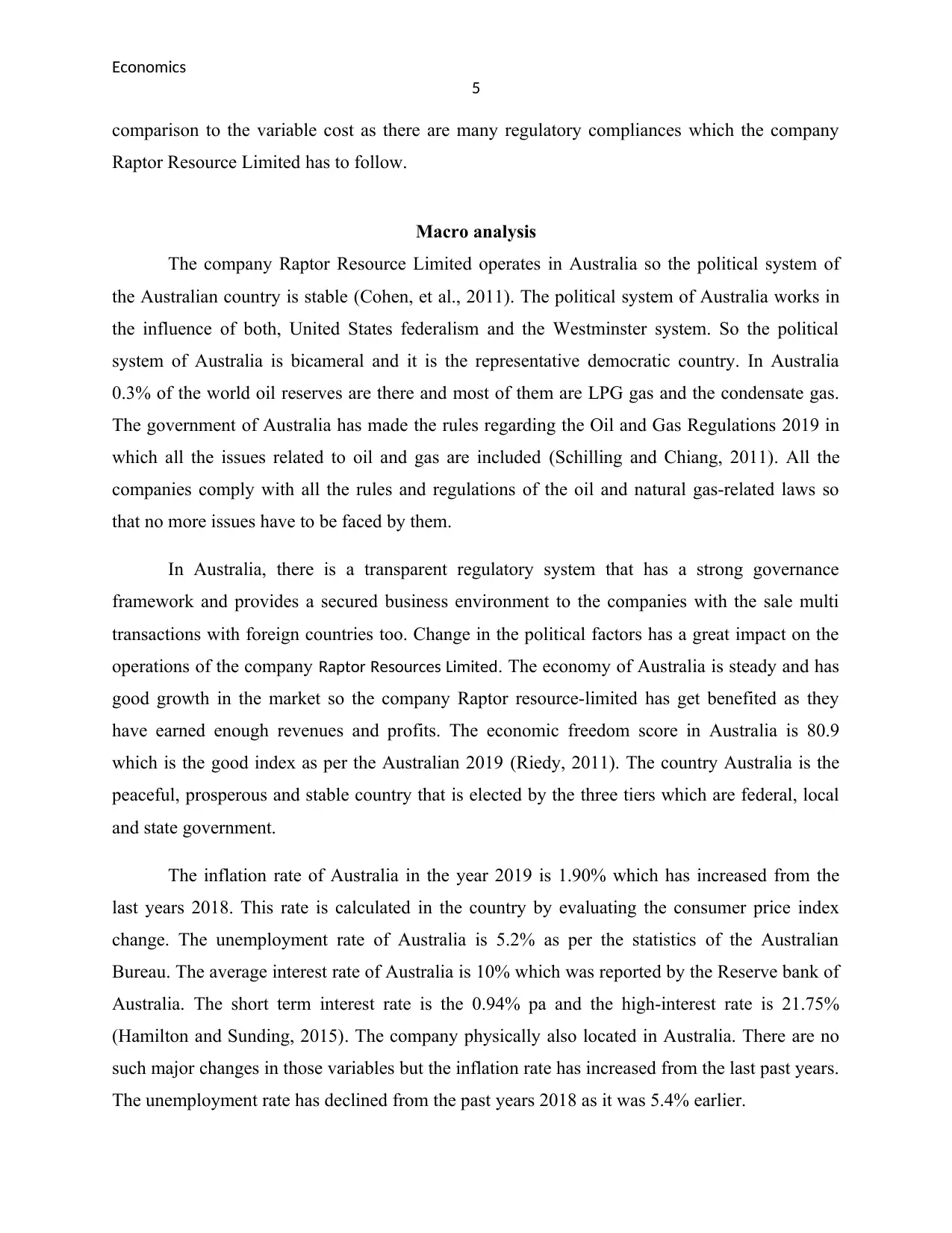
Economics
5
comparison to the variable cost as there are many regulatory compliances which the company
Raptor Resource Limited has to follow.
Macro analysis
The company Raptor Resource Limited operates in Australia so the political system of
the Australian country is stable (Cohen, et al., 2011). The political system of Australia works in
the influence of both, United States federalism and the Westminster system. So the political
system of Australia is bicameral and it is the representative democratic country. In Australia
0.3% of the world oil reserves are there and most of them are LPG gas and the condensate gas.
The government of Australia has made the rules regarding the Oil and Gas Regulations 2019 in
which all the issues related to oil and gas are included (Schilling and Chiang, 2011). All the
companies comply with all the rules and regulations of the oil and natural gas-related laws so
that no more issues have to be faced by them.
In Australia, there is a transparent regulatory system that has a strong governance
framework and provides a secured business environment to the companies with the sale multi
transactions with foreign countries too. Change in the political factors has a great impact on the
operations of the company Raptor Resources Limited. The economy of Australia is steady and has
good growth in the market so the company Raptor resource-limited has get benefited as they
have earned enough revenues and profits. The economic freedom score in Australia is 80.9
which is the good index as per the Australian 2019 (Riedy, 2011). The country Australia is the
peaceful, prosperous and stable country that is elected by the three tiers which are federal, local
and state government.
The inflation rate of Australia in the year 2019 is 1.90% which has increased from the
last years 2018. This rate is calculated in the country by evaluating the consumer price index
change. The unemployment rate of Australia is 5.2% as per the statistics of the Australian
Bureau. The average interest rate of Australia is 10% which was reported by the Reserve bank of
Australia. The short term interest rate is the 0.94% pa and the high-interest rate is 21.75%
(Hamilton and Sunding, 2015). The company physically also located in Australia. There are no
such major changes in those variables but the inflation rate has increased from the last past years.
The unemployment rate has declined from the past years 2018 as it was 5.4% earlier.
5
comparison to the variable cost as there are many regulatory compliances which the company
Raptor Resource Limited has to follow.
Macro analysis
The company Raptor Resource Limited operates in Australia so the political system of
the Australian country is stable (Cohen, et al., 2011). The political system of Australia works in
the influence of both, United States federalism and the Westminster system. So the political
system of Australia is bicameral and it is the representative democratic country. In Australia
0.3% of the world oil reserves are there and most of them are LPG gas and the condensate gas.
The government of Australia has made the rules regarding the Oil and Gas Regulations 2019 in
which all the issues related to oil and gas are included (Schilling and Chiang, 2011). All the
companies comply with all the rules and regulations of the oil and natural gas-related laws so
that no more issues have to be faced by them.
In Australia, there is a transparent regulatory system that has a strong governance
framework and provides a secured business environment to the companies with the sale multi
transactions with foreign countries too. Change in the political factors has a great impact on the
operations of the company Raptor Resources Limited. The economy of Australia is steady and has
good growth in the market so the company Raptor resource-limited has get benefited as they
have earned enough revenues and profits. The economic freedom score in Australia is 80.9
which is the good index as per the Australian 2019 (Riedy, 2011). The country Australia is the
peaceful, prosperous and stable country that is elected by the three tiers which are federal, local
and state government.
The inflation rate of Australia in the year 2019 is 1.90% which has increased from the
last years 2018. This rate is calculated in the country by evaluating the consumer price index
change. The unemployment rate of Australia is 5.2% as per the statistics of the Australian
Bureau. The average interest rate of Australia is 10% which was reported by the Reserve bank of
Australia. The short term interest rate is the 0.94% pa and the high-interest rate is 21.75%
(Hamilton and Sunding, 2015). The company physically also located in Australia. There are no
such major changes in those variables but the inflation rate has increased from the last past years.
The unemployment rate has declined from the past years 2018 as it was 5.4% earlier.
⊘ This is a preview!⊘
Do you want full access?
Subscribe today to unlock all pages.

Trusted by 1+ million students worldwide
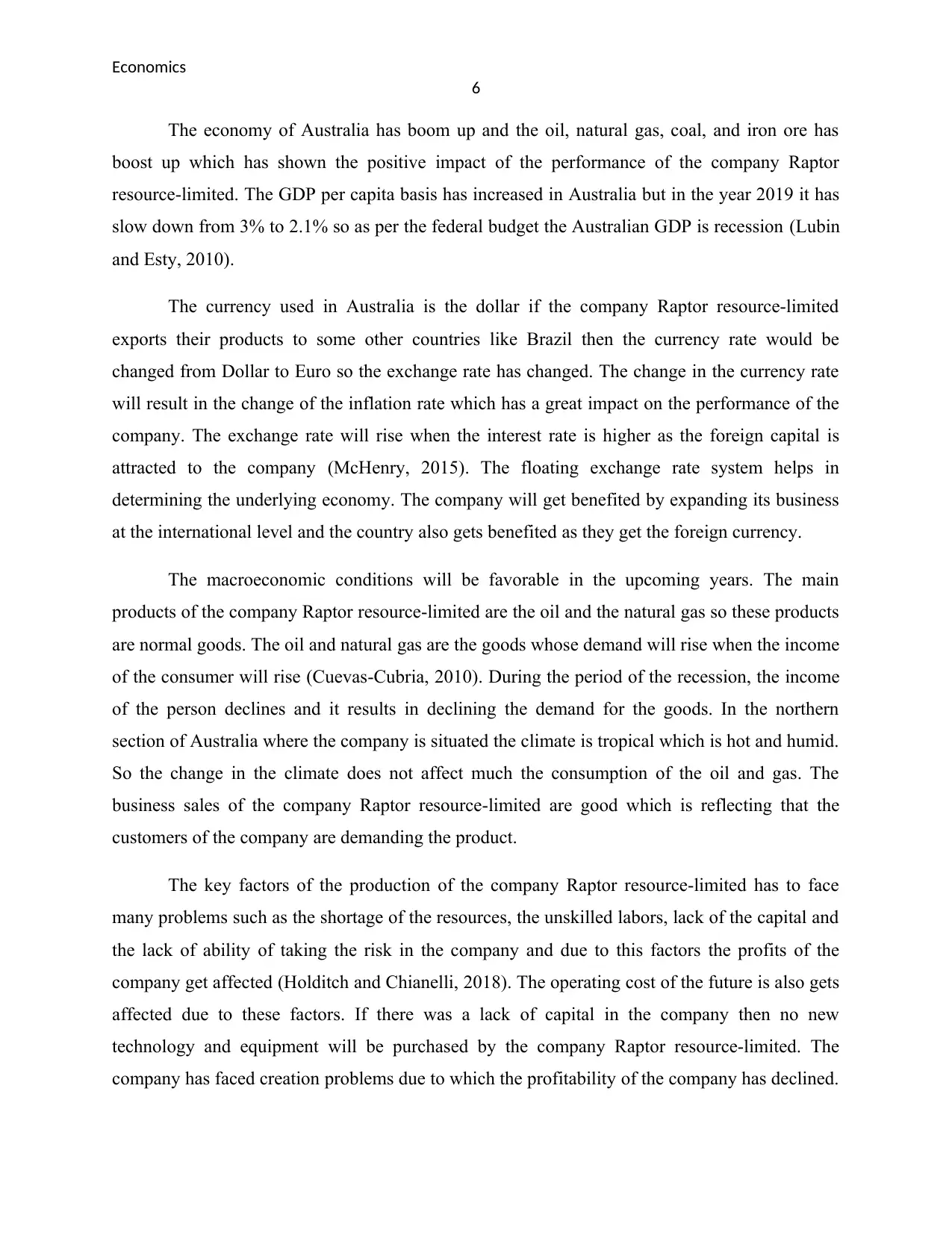
Economics
6
The economy of Australia has boom up and the oil, natural gas, coal, and iron ore has
boost up which has shown the positive impact of the performance of the company Raptor
resource-limited. The GDP per capita basis has increased in Australia but in the year 2019 it has
slow down from 3% to 2.1% so as per the federal budget the Australian GDP is recession (Lubin
and Esty, 2010).
The currency used in Australia is the dollar if the company Raptor resource-limited
exports their products to some other countries like Brazil then the currency rate would be
changed from Dollar to Euro so the exchange rate has changed. The change in the currency rate
will result in the change of the inflation rate which has a great impact on the performance of the
company. The exchange rate will rise when the interest rate is higher as the foreign capital is
attracted to the company (McHenry, 2015). The floating exchange rate system helps in
determining the underlying economy. The company will get benefited by expanding its business
at the international level and the country also gets benefited as they get the foreign currency.
The macroeconomic conditions will be favorable in the upcoming years. The main
products of the company Raptor resource-limited are the oil and the natural gas so these products
are normal goods. The oil and natural gas are the goods whose demand will rise when the income
of the consumer will rise (Cuevas-Cubria, 2010). During the period of the recession, the income
of the person declines and it results in declining the demand for the goods. In the northern
section of Australia where the company is situated the climate is tropical which is hot and humid.
So the change in the climate does not affect much the consumption of the oil and gas. The
business sales of the company Raptor resource-limited are good which is reflecting that the
customers of the company are demanding the product.
The key factors of the production of the company Raptor resource-limited has to face
many problems such as the shortage of the resources, the unskilled labors, lack of the capital and
the lack of ability of taking the risk in the company and due to this factors the profits of the
company get affected (Holditch and Chianelli, 2018). The operating cost of the future is also gets
affected due to these factors. If there was a lack of capital in the company then no new
technology and equipment will be purchased by the company Raptor resource-limited. The
company has faced creation problems due to which the profitability of the company has declined.
6
The economy of Australia has boom up and the oil, natural gas, coal, and iron ore has
boost up which has shown the positive impact of the performance of the company Raptor
resource-limited. The GDP per capita basis has increased in Australia but in the year 2019 it has
slow down from 3% to 2.1% so as per the federal budget the Australian GDP is recession (Lubin
and Esty, 2010).
The currency used in Australia is the dollar if the company Raptor resource-limited
exports their products to some other countries like Brazil then the currency rate would be
changed from Dollar to Euro so the exchange rate has changed. The change in the currency rate
will result in the change of the inflation rate which has a great impact on the performance of the
company. The exchange rate will rise when the interest rate is higher as the foreign capital is
attracted to the company (McHenry, 2015). The floating exchange rate system helps in
determining the underlying economy. The company will get benefited by expanding its business
at the international level and the country also gets benefited as they get the foreign currency.
The macroeconomic conditions will be favorable in the upcoming years. The main
products of the company Raptor resource-limited are the oil and the natural gas so these products
are normal goods. The oil and natural gas are the goods whose demand will rise when the income
of the consumer will rise (Cuevas-Cubria, 2010). During the period of the recession, the income
of the person declines and it results in declining the demand for the goods. In the northern
section of Australia where the company is situated the climate is tropical which is hot and humid.
So the change in the climate does not affect much the consumption of the oil and gas. The
business sales of the company Raptor resource-limited are good which is reflecting that the
customers of the company are demanding the product.
The key factors of the production of the company Raptor resource-limited has to face
many problems such as the shortage of the resources, the unskilled labors, lack of the capital and
the lack of ability of taking the risk in the company and due to this factors the profits of the
company get affected (Holditch and Chianelli, 2018). The operating cost of the future is also gets
affected due to these factors. If there was a lack of capital in the company then no new
technology and equipment will be purchased by the company Raptor resource-limited. The
company has faced creation problems due to which the profitability of the company has declined.
Paraphrase This Document
Need a fresh take? Get an instant paraphrase of this document with our AI Paraphraser
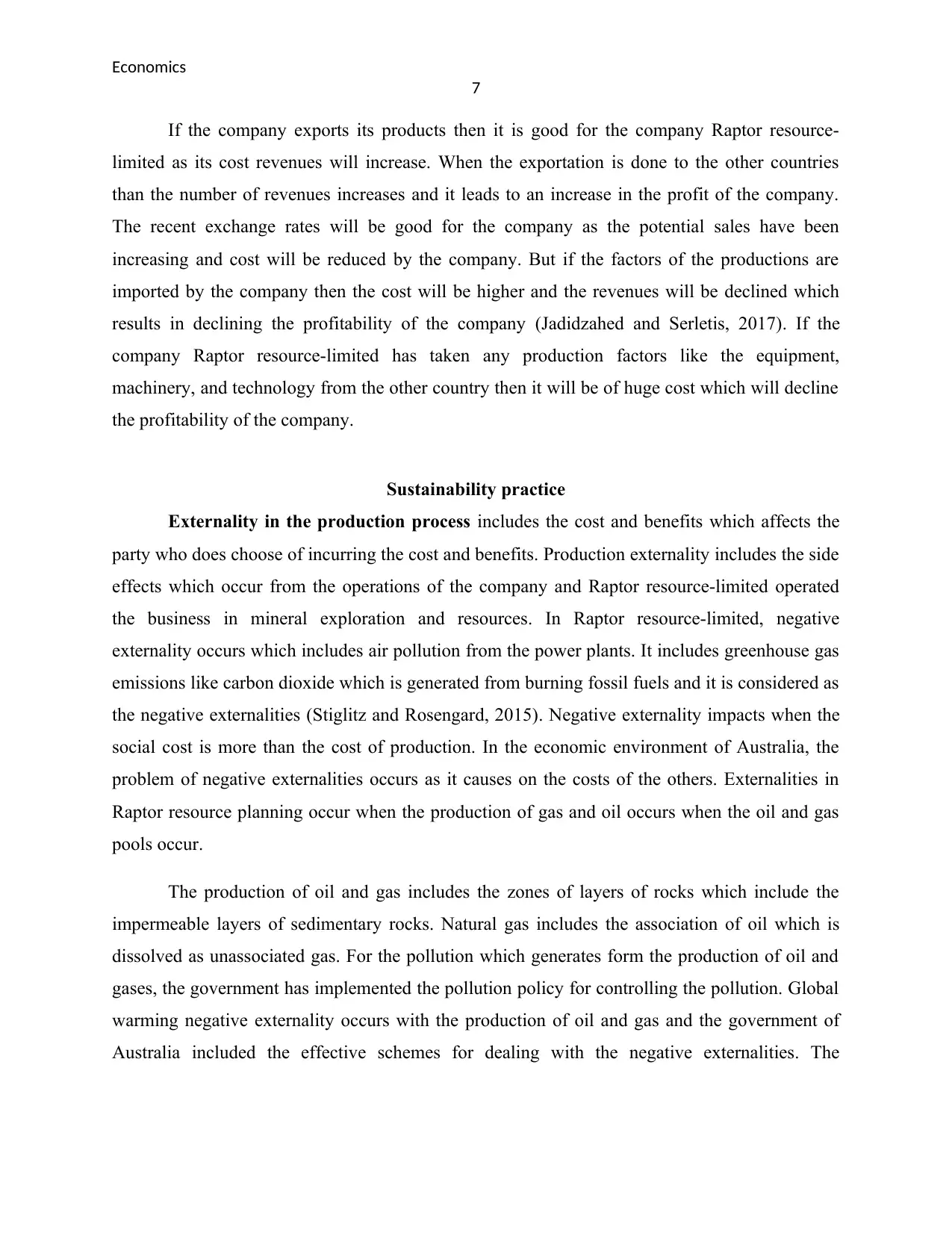
Economics
7
If the company exports its products then it is good for the company Raptor resource-
limited as its cost revenues will increase. When the exportation is done to the other countries
than the number of revenues increases and it leads to an increase in the profit of the company.
The recent exchange rates will be good for the company as the potential sales have been
increasing and cost will be reduced by the company. But if the factors of the productions are
imported by the company then the cost will be higher and the revenues will be declined which
results in declining the profitability of the company (Jadidzahed and Serletis, 2017). If the
company Raptor resource-limited has taken any production factors like the equipment,
machinery, and technology from the other country then it will be of huge cost which will decline
the profitability of the company.
Sustainability practice
Externality in the production process includes the cost and benefits which affects the
party who does choose of incurring the cost and benefits. Production externality includes the side
effects which occur from the operations of the company and Raptor resource-limited operated
the business in mineral exploration and resources. In Raptor resource-limited, negative
externality occurs which includes air pollution from the power plants. It includes greenhouse gas
emissions like carbon dioxide which is generated from burning fossil fuels and it is considered as
the negative externalities (Stiglitz and Rosengard, 2015). Negative externality impacts when the
social cost is more than the cost of production. In the economic environment of Australia, the
problem of negative externalities occurs as it causes on the costs of the others. Externalities in
Raptor resource planning occur when the production of gas and oil occurs when the oil and gas
pools occur.
The production of oil and gas includes the zones of layers of rocks which include the
impermeable layers of sedimentary rocks. Natural gas includes the association of oil which is
dissolved as unassociated gas. For the pollution which generates form the production of oil and
gases, the government has implemented the pollution policy for controlling the pollution. Global
warming negative externality occurs with the production of oil and gas and the government of
Australia included the effective schemes for dealing with the negative externalities. The
7
If the company exports its products then it is good for the company Raptor resource-
limited as its cost revenues will increase. When the exportation is done to the other countries
than the number of revenues increases and it leads to an increase in the profit of the company.
The recent exchange rates will be good for the company as the potential sales have been
increasing and cost will be reduced by the company. But if the factors of the productions are
imported by the company then the cost will be higher and the revenues will be declined which
results in declining the profitability of the company (Jadidzahed and Serletis, 2017). If the
company Raptor resource-limited has taken any production factors like the equipment,
machinery, and technology from the other country then it will be of huge cost which will decline
the profitability of the company.
Sustainability practice
Externality in the production process includes the cost and benefits which affects the
party who does choose of incurring the cost and benefits. Production externality includes the side
effects which occur from the operations of the company and Raptor resource-limited operated
the business in mineral exploration and resources. In Raptor resource-limited, negative
externality occurs which includes air pollution from the power plants. It includes greenhouse gas
emissions like carbon dioxide which is generated from burning fossil fuels and it is considered as
the negative externalities (Stiglitz and Rosengard, 2015). Negative externality impacts when the
social cost is more than the cost of production. In the economic environment of Australia, the
problem of negative externalities occurs as it causes on the costs of the others. Externalities in
Raptor resource planning occur when the production of gas and oil occurs when the oil and gas
pools occur.
The production of oil and gas includes the zones of layers of rocks which include the
impermeable layers of sedimentary rocks. Natural gas includes the association of oil which is
dissolved as unassociated gas. For the pollution which generates form the production of oil and
gases, the government has implemented the pollution policy for controlling the pollution. Global
warming negative externality occurs with the production of oil and gas and the government of
Australia included the effective schemes for dealing with the negative externalities. The
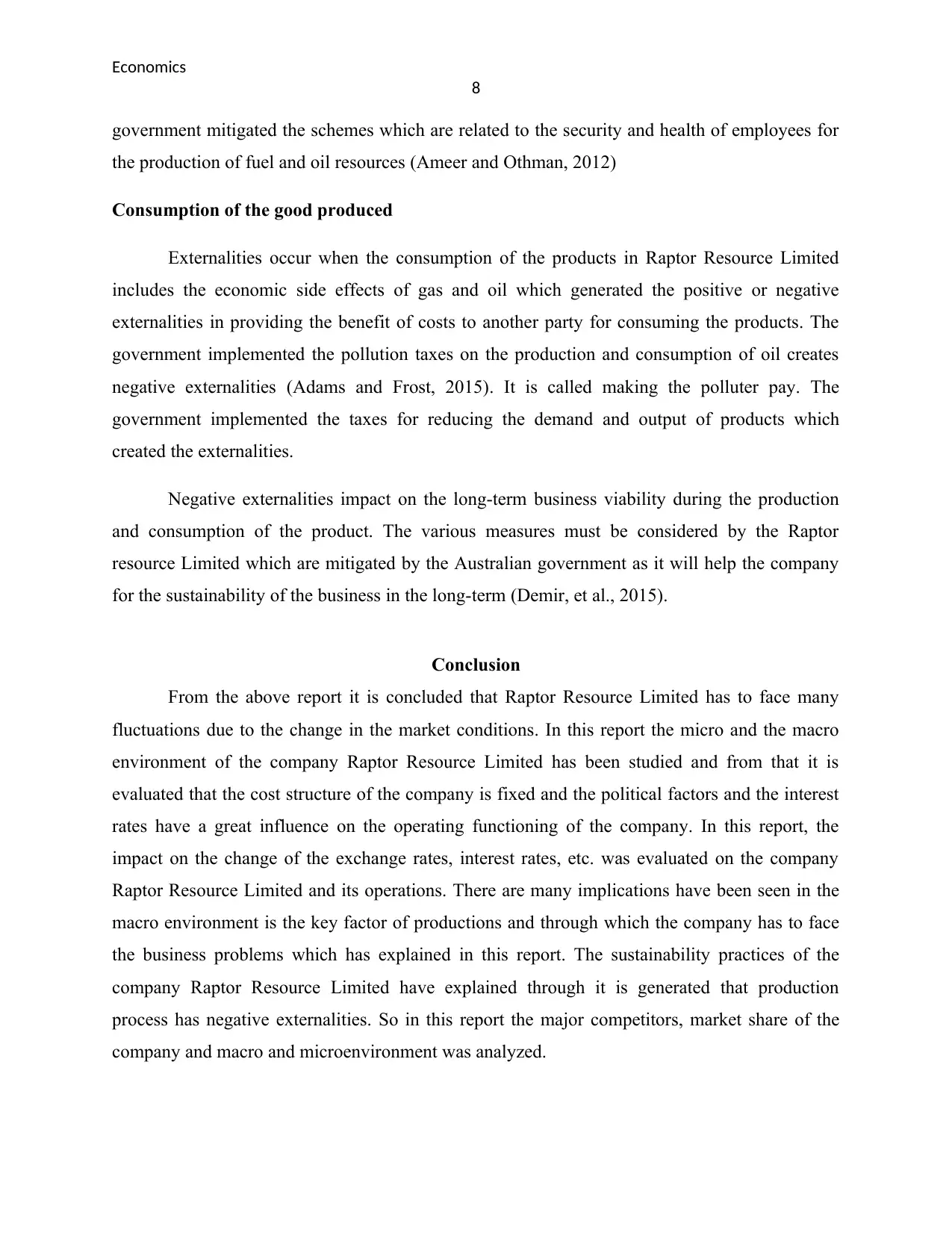
Economics
8
government mitigated the schemes which are related to the security and health of employees for
the production of fuel and oil resources (Ameer and Othman, 2012)
Consumption of the good produced
Externalities occur when the consumption of the products in Raptor Resource Limited
includes the economic side effects of gas and oil which generated the positive or negative
externalities in providing the benefit of costs to another party for consuming the products. The
government implemented the pollution taxes on the production and consumption of oil creates
negative externalities (Adams and Frost, 2015). It is called making the polluter pay. The
government implemented the taxes for reducing the demand and output of products which
created the externalities.
Negative externalities impact on the long-term business viability during the production
and consumption of the product. The various measures must be considered by the Raptor
resource Limited which are mitigated by the Australian government as it will help the company
for the sustainability of the business in the long-term (Demir, et al., 2015).
Conclusion
From the above report it is concluded that Raptor Resource Limited has to face many
fluctuations due to the change in the market conditions. In this report the micro and the macro
environment of the company Raptor Resource Limited has been studied and from that it is
evaluated that the cost structure of the company is fixed and the political factors and the interest
rates have a great influence on the operating functioning of the company. In this report, the
impact on the change of the exchange rates, interest rates, etc. was evaluated on the company
Raptor Resource Limited and its operations. There are many implications have been seen in the
macro environment is the key factor of productions and through which the company has to face
the business problems which has explained in this report. The sustainability practices of the
company Raptor Resource Limited have explained through it is generated that production
process has negative externalities. So in this report the major competitors, market share of the
company and macro and microenvironment was analyzed.
8
government mitigated the schemes which are related to the security and health of employees for
the production of fuel and oil resources (Ameer and Othman, 2012)
Consumption of the good produced
Externalities occur when the consumption of the products in Raptor Resource Limited
includes the economic side effects of gas and oil which generated the positive or negative
externalities in providing the benefit of costs to another party for consuming the products. The
government implemented the pollution taxes on the production and consumption of oil creates
negative externalities (Adams and Frost, 2015). It is called making the polluter pay. The
government implemented the taxes for reducing the demand and output of products which
created the externalities.
Negative externalities impact on the long-term business viability during the production
and consumption of the product. The various measures must be considered by the Raptor
resource Limited which are mitigated by the Australian government as it will help the company
for the sustainability of the business in the long-term (Demir, et al., 2015).
Conclusion
From the above report it is concluded that Raptor Resource Limited has to face many
fluctuations due to the change in the market conditions. In this report the micro and the macro
environment of the company Raptor Resource Limited has been studied and from that it is
evaluated that the cost structure of the company is fixed and the political factors and the interest
rates have a great influence on the operating functioning of the company. In this report, the
impact on the change of the exchange rates, interest rates, etc. was evaluated on the company
Raptor Resource Limited and its operations. There are many implications have been seen in the
macro environment is the key factor of productions and through which the company has to face
the business problems which has explained in this report. The sustainability practices of the
company Raptor Resource Limited have explained through it is generated that production
process has negative externalities. So in this report the major competitors, market share of the
company and macro and microenvironment was analyzed.
⊘ This is a preview!⊘
Do you want full access?
Subscribe today to unlock all pages.

Trusted by 1+ million students worldwide
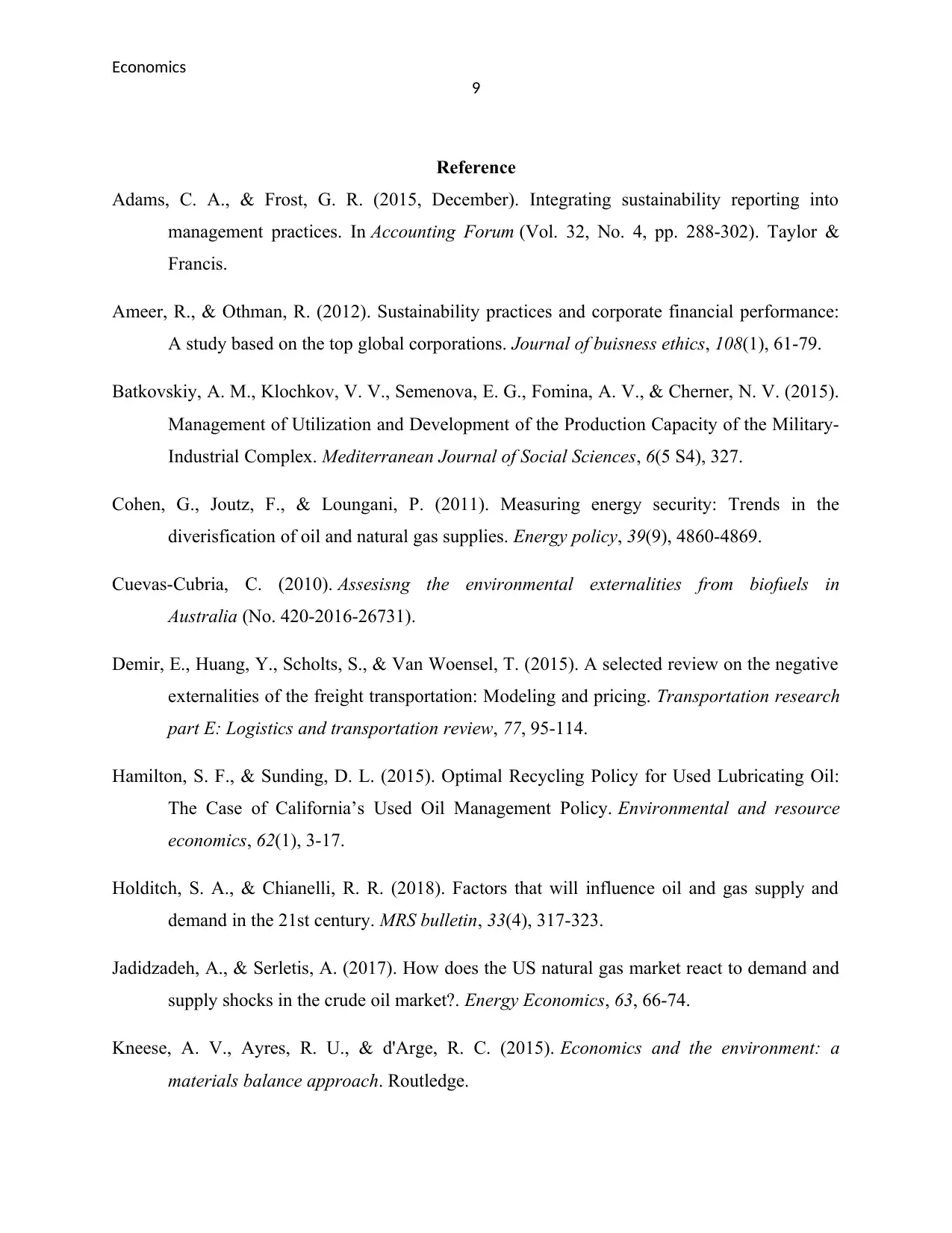
Economics
9
Reference
Adams, C. A., & Frost, G. R. (2015, December). Integrating sustainability reporting into
management practices. In Accounting Forum (Vol. 32, No. 4, pp. 288-302). Taylor &
Francis.
Ameer, R., & Othman, R. (2012). Sustainability practices and corporate financial performance:
A study based on the top global corporations. Journal of buisness ethics, 108(1), 61-79.
Batkovskiy, A. M., Klochkov, V. V., Semenova, E. G., Fomina, A. V., & Cherner, N. V. (2015).
Management of Utilization and Development of the Production Capacity of the Military-
Industrial Complex. Mediterranean Journal of Social Sciences, 6(5 S4), 327.
Cohen, G., Joutz, F., & Loungani, P. (2011). Measuring energy security: Trends in the
diverisfication of oil and natural gas supplies. Energy policy, 39(9), 4860-4869.
Cuevas-Cubria, C. (2010). Assesisng the environmental externalities from biofuels in
Australia (No. 420-2016-26731).
Demir, E., Huang, Y., Scholts, S., & Van Woensel, T. (2015). A selected review on the negative
externalities of the freight transportation: Modeling and pricing. Transportation research
part E: Logistics and transportation review, 77, 95-114.
Hamilton, S. F., & Sunding, D. L. (2015). Optimal Recycling Policy for Used Lubricating Oil:
The Case of California’s Used Oil Management Policy. Environmental and resource
economics, 62(1), 3-17.
Holditch, S. A., & Chianelli, R. R. (2018). Factors that will influence oil and gas supply and
demand in the 21st century. MRS bulletin, 33(4), 317-323.
Jadidzadeh, A., & Serletis, A. (2017). How does the US natural gas market react to demand and
supply shocks in the crude oil market?. Energy Economics, 63, 66-74.
Kneese, A. V., Ayres, R. U., & d'Arge, R. C. (2015). Economics and the environment: a
materials balance approach. Routledge.
9
Reference
Adams, C. A., & Frost, G. R. (2015, December). Integrating sustainability reporting into
management practices. In Accounting Forum (Vol. 32, No. 4, pp. 288-302). Taylor &
Francis.
Ameer, R., & Othman, R. (2012). Sustainability practices and corporate financial performance:
A study based on the top global corporations. Journal of buisness ethics, 108(1), 61-79.
Batkovskiy, A. M., Klochkov, V. V., Semenova, E. G., Fomina, A. V., & Cherner, N. V. (2015).
Management of Utilization and Development of the Production Capacity of the Military-
Industrial Complex. Mediterranean Journal of Social Sciences, 6(5 S4), 327.
Cohen, G., Joutz, F., & Loungani, P. (2011). Measuring energy security: Trends in the
diverisfication of oil and natural gas supplies. Energy policy, 39(9), 4860-4869.
Cuevas-Cubria, C. (2010). Assesisng the environmental externalities from biofuels in
Australia (No. 420-2016-26731).
Demir, E., Huang, Y., Scholts, S., & Van Woensel, T. (2015). A selected review on the negative
externalities of the freight transportation: Modeling and pricing. Transportation research
part E: Logistics and transportation review, 77, 95-114.
Hamilton, S. F., & Sunding, D. L. (2015). Optimal Recycling Policy for Used Lubricating Oil:
The Case of California’s Used Oil Management Policy. Environmental and resource
economics, 62(1), 3-17.
Holditch, S. A., & Chianelli, R. R. (2018). Factors that will influence oil and gas supply and
demand in the 21st century. MRS bulletin, 33(4), 317-323.
Jadidzadeh, A., & Serletis, A. (2017). How does the US natural gas market react to demand and
supply shocks in the crude oil market?. Energy Economics, 63, 66-74.
Kneese, A. V., Ayres, R. U., & d'Arge, R. C. (2015). Economics and the environment: a
materials balance approach. Routledge.
Paraphrase This Document
Need a fresh take? Get an instant paraphrase of this document with our AI Paraphraser
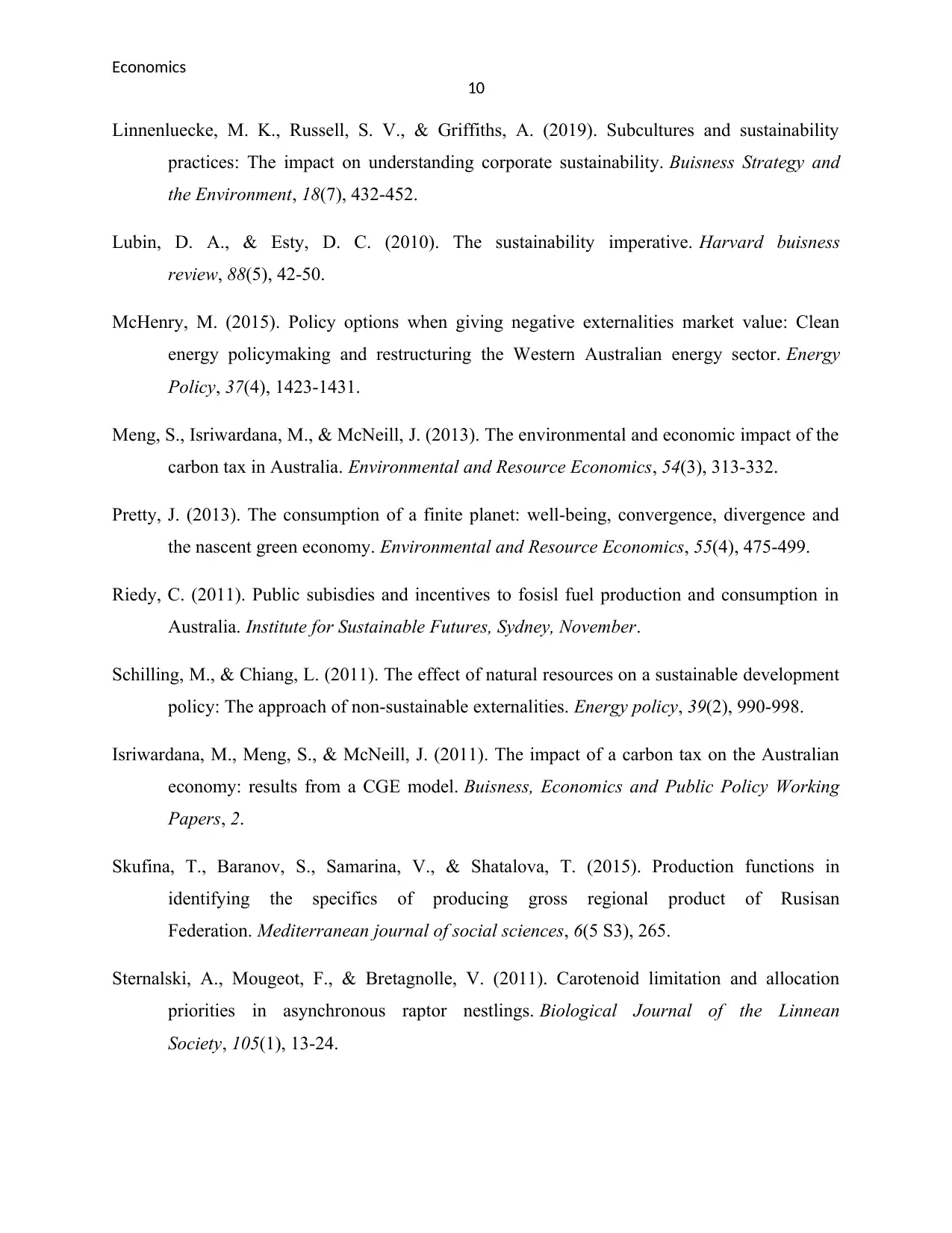
Economics
10
Linnenluecke, M. K., Russell, S. V., & Griffiths, A. (2019). Subcultures and sustainability
practices: The impact on understanding corporate sustainability. Buisness Strategy and
the Environment, 18(7), 432-452.
Lubin, D. A., & Esty, D. C. (2010). The sustainability imperative. Harvard buisness
review, 88(5), 42-50.
McHenry, M. (2015). Policy options when giving negative externalities market value: Clean
energy policymaking and restructuring the Western Australian energy sector. Energy
Policy, 37(4), 1423-1431.
Meng, S., Isriwardana, M., & McNeill, J. (2013). The environmental and economic impact of the
carbon tax in Australia. Environmental and Resource Economics, 54(3), 313-332.
Pretty, J. (2013). The consumption of a finite planet: well-being, convergence, divergence and
the nascent green economy. Environmental and Resource Economics, 55(4), 475-499.
Riedy, C. (2011). Public subisdies and incentives to fosisl fuel production and consumption in
Australia. Institute for Sustainable Futures, Sydney, November.
Schilling, M., & Chiang, L. (2011). The effect of natural resources on a sustainable development
policy: The approach of non-sustainable externalities. Energy policy, 39(2), 990-998.
Isriwardana, M., Meng, S., & McNeill, J. (2011). The impact of a carbon tax on the Australian
economy: results from a CGE model. Buisness, Economics and Public Policy Working
Papers, 2.
Skufina, T., Baranov, S., Samarina, V., & Shatalova, T. (2015). Production functions in
identifying the specifics of producing gross regional product of Rusisan
Federation. Mediterranean journal of social sciences, 6(5 S3), 265.
Sternalski, A., Mougeot, F., & Bretagnolle, V. (2011). Carotenoid limitation and allocation
priorities in asynchronous raptor nestlings. Biological Journal of the Linnean
Society, 105(1), 13-24.
10
Linnenluecke, M. K., Russell, S. V., & Griffiths, A. (2019). Subcultures and sustainability
practices: The impact on understanding corporate sustainability. Buisness Strategy and
the Environment, 18(7), 432-452.
Lubin, D. A., & Esty, D. C. (2010). The sustainability imperative. Harvard buisness
review, 88(5), 42-50.
McHenry, M. (2015). Policy options when giving negative externalities market value: Clean
energy policymaking and restructuring the Western Australian energy sector. Energy
Policy, 37(4), 1423-1431.
Meng, S., Isriwardana, M., & McNeill, J. (2013). The environmental and economic impact of the
carbon tax in Australia. Environmental and Resource Economics, 54(3), 313-332.
Pretty, J. (2013). The consumption of a finite planet: well-being, convergence, divergence and
the nascent green economy. Environmental and Resource Economics, 55(4), 475-499.
Riedy, C. (2011). Public subisdies and incentives to fosisl fuel production and consumption in
Australia. Institute for Sustainable Futures, Sydney, November.
Schilling, M., & Chiang, L. (2011). The effect of natural resources on a sustainable development
policy: The approach of non-sustainable externalities. Energy policy, 39(2), 990-998.
Isriwardana, M., Meng, S., & McNeill, J. (2011). The impact of a carbon tax on the Australian
economy: results from a CGE model. Buisness, Economics and Public Policy Working
Papers, 2.
Skufina, T., Baranov, S., Samarina, V., & Shatalova, T. (2015). Production functions in
identifying the specifics of producing gross regional product of Rusisan
Federation. Mediterranean journal of social sciences, 6(5 S3), 265.
Sternalski, A., Mougeot, F., & Bretagnolle, V. (2011). Carotenoid limitation and allocation
priorities in asynchronous raptor nestlings. Biological Journal of the Linnean
Society, 105(1), 13-24.
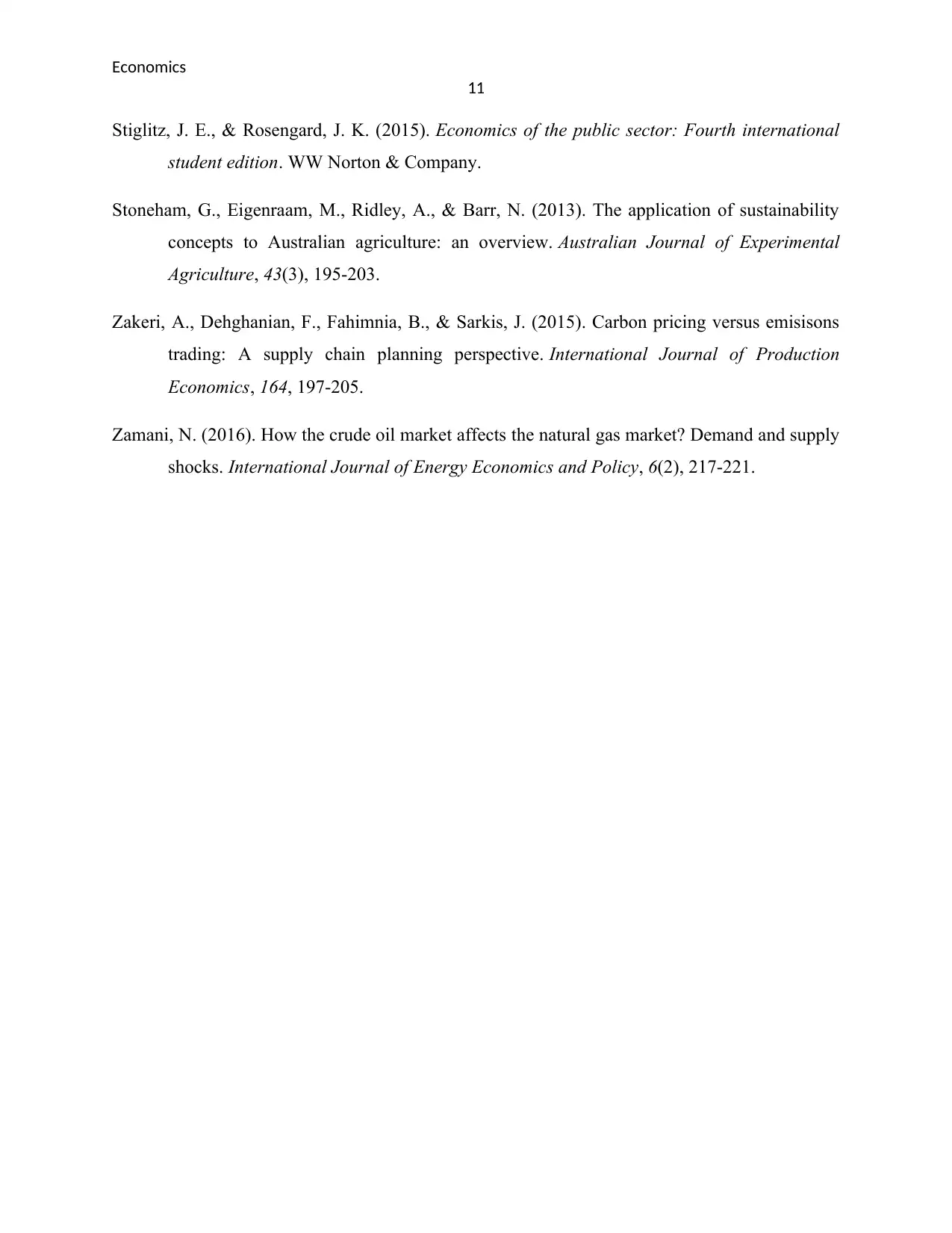
Economics
11
Stiglitz, J. E., & Rosengard, J. K. (2015). Economics of the public sector: Fourth international
student edition. WW Norton & Company.
Stoneham, G., Eigenraam, M., Ridley, A., & Barr, N. (2013). The application of sustainability
concepts to Australian agriculture: an overview. Australian Journal of Experimental
Agriculture, 43(3), 195-203.
Zakeri, A., Dehghanian, F., Fahimnia, B., & Sarkis, J. (2015). Carbon pricing versus emisisons
trading: A supply chain planning perspective. International Journal of Production
Economics, 164, 197-205.
Zamani, N. (2016). How the crude oil market affects the natural gas market? Demand and supply
shocks. International Journal of Energy Economics and Policy, 6(2), 217-221.
11
Stiglitz, J. E., & Rosengard, J. K. (2015). Economics of the public sector: Fourth international
student edition. WW Norton & Company.
Stoneham, G., Eigenraam, M., Ridley, A., & Barr, N. (2013). The application of sustainability
concepts to Australian agriculture: an overview. Australian Journal of Experimental
Agriculture, 43(3), 195-203.
Zakeri, A., Dehghanian, F., Fahimnia, B., & Sarkis, J. (2015). Carbon pricing versus emisisons
trading: A supply chain planning perspective. International Journal of Production
Economics, 164, 197-205.
Zamani, N. (2016). How the crude oil market affects the natural gas market? Demand and supply
shocks. International Journal of Energy Economics and Policy, 6(2), 217-221.
⊘ This is a preview!⊘
Do you want full access?
Subscribe today to unlock all pages.

Trusted by 1+ million students worldwide
1 out of 12
Related Documents
Your All-in-One AI-Powered Toolkit for Academic Success.
+13062052269
info@desklib.com
Available 24*7 on WhatsApp / Email
![[object Object]](/_next/static/media/star-bottom.7253800d.svg)
Unlock your academic potential
Copyright © 2020–2025 A2Z Services. All Rights Reserved. Developed and managed by ZUCOL.





